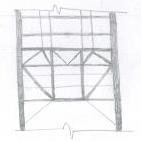Search the Community
Showing results for tags 'response spectrum'.
-
Assalam O Alykum I am having confusion by applying scale factor in E-tabs program in response spectrum mode after performing 2 different checks Check number-1 1. After getting more than 90% of mass participation factor along Ux , Uy direction and get the displacement value for example In Ux I multiplied the elastic displacement value of Ux by x Cd/I to get the In-elastic displacement . Delta In-elastic = 18.5x4.5/1.5 = 55.5mm Check number-2 2 After getting more than 90% of mass participation factor along Ux , Uy direction I multiplied the scale factor directly by Cd/I and my assumption is that, by that way program will give Inelastic displacement directly. But displacement values are not matched in both checks. What will be the possible reason of getting two different values having difference of 15mm. Is my question is clear yes / no Anybody can advise specially seniors
-
First of all my apologies, if my question seems stupid because of my unfamiliarity with the topic. When defining response spectrum load case in ETABS, we have three directions; u1, u2 and u3. Lets assume the excitation angle = 0 and building principle direction is u1 So I will apply response spectrum function (per IBC 2006) in u1 direction by a scale factor. My question is why we don't apply u2 and u3 in the SAME LOAD CASE. My understanding is, according to WILSON in his book on STATIC & DYNAMIC ANALYSIS, CHAPTER 15. The response is calculated for each direction separately. Then this response is combined by different methods (CQC, SRSS etc) which is called MODEL COMBINATION. In CQC method response in 2 directions is assumed to be a portion of 1 direction means S2=a.S1 Where a = 0 to 1.0, recommended value is 0.50 to 0.85 I know in EQ building has only one principle direction. Although EQ can hit from any direction but there is always one major direction. or you can say major acceleration in 1 direction. Lets say u1. As in CQC method the response in other direction will be some portion of response in major direction. I also know that If we have equal spectra CQC is reduced to SRSS method which is independent from the excitation angle theta. My confusion is we will do MODAL COMBINATION (cqc or srss) only when we want to combine u1, u2 and u3 at the same time. But if we are applying only u1 in one response spectrum load case, then we DONT have to do modal combination. It is the same thing as in CQC S2=a. S1. Now in this case a=0. so S2=0. All we have is only response in u1 direction. Then in my building models what i do? include u1 and u2 both in one load case or in separate load cases?
-
Hello All, Just wanted to know i have shake table data in terms of Time Acceleration and Time Displacement from a specific ground acceleration, i wanted to know how can i convert that data to Response Spectrum so that i can evaluate for different structure having different time periods, as far as i know i need to solve equation of motion somehow , anyone having knowledge regarding it can forward me literature or any kind of would be really appreciated, Thanks
-
- response spectrum
- sdof
-
(and 1 more)
Tagged with:
-
While defining scale factor of response spectrum. We define it (I*g)/2R in some case and g only in some case why?
-
Dear friends, Can any body share some examples on dynamic analysis to calculate earthquake forces on buildings. Need information how to make number of modes and what should be the scale factor? Regards Sohaib
- 22 replies
-
- Dynamic Analysis Example
- Response Spectrum
-
(and 1 more)
Tagged with:
-
Dear All If we doing response spectrum analysis as per UBC. do we need to lower our base shear because in UBC it is stated that direct result from spectrum shall be used to design for eerthquakes. If we do so then where is R value.
-
Hello everyone, I hope all of you will be fine. In etabs when we apply Response Spectrum loading on a multistoried building with 2 basement floors. At what floor level this loading will be applied as in equivalent static seismic analysis, we can apply EQX & EQY on any floor we like as this option is available in etabs but the problem is with response spectrum and time history analysis. please if someone knows and have the experince, share it i shall be very thankful.
-
IRJET-V5I249 (1).pdf
-
Hi, can someone advice me about time history analysis, when we should use response spectrum and when to use a time history analysis whether it depend on the building height? the building seismic design category or? I'm very appreciete if someone willing to advice Thanks
-
How can I transfer response spectrum loads from etabs to safe
-
First , I am Very Happy to Participate in Forum Such As This Forum , I need to Make Engineering Discussion With These Questions 1. Why We Make Scale Factor Between Static And Dynamic Seismic Analysis ? 2. After Scale Factor We Design By Load Combinations Included Dynamic Cases Only Or Static Load Only Or Dynamic And Static ? 3. What is Diaphragm And What is Importance of Diaphragm In Seismic And Wind? 4. When We Define Diaphragm? And We Define As Rigid Or Semi Rigid And What is the Different Between Them? 5. Different Between Displacement And Drift Due to Seismic ? 6. Displacement Due to Seismic Results From Etabs We Multiply it X 0.70 X R ,Why And What About Drift ? 7. We Make 3 Cases For Each Case ( X AND Y ) in Static Analysis What About Dynamic Same Or Not Static Analysis Ex Ex With + Eccentricity Ex With – Eccentricity Ey Ey With + Eccentricity Ey With – Eccentricity 8. Why We Don't Combine Seismic And Wind in Load Combinations? 9. In Dynamic Analysis , Forces Cause Mode Shapes Or Mode Shapes Cause Forces? 10. Difference Between Response Spectrum ( Dynamic ) And Time History , Which Best? 11. What is the Effect of Seismic in Slabs And Beams? 12. Design Of Slabs And Beams By Load Combination Included Seismic Right Or Wrong? 13. After Finishing 3D Model , What are the Checks For Seismic? 14. Slab On Grade , I Put In Etabs Or Not ? 15. How Building Make Damping For Seismic ,What is Factors Damping Depend on? 16. Different Between Point Drift – Story Drift – Diaphragm Drift ?
-
The document starts with the statement, "Ray Clough and I regret we created the approximate response spectrum method for seismic analysis of structures in 1962". Termination.pdf
-
Dear all , Can any one tell me the difference between Spectral Acceleration / g Spectral Acceleration / PGA Are they mean same in the response spectrum . can any one explain e
-
for analysis of tall buildings whether i should use response spectrum analysis or time history analysis.if i have to use time history analysis then there is a wide range range of earthquakes to be considered in analysis?if someone has about this plz post it.
- 2 replies
-
- response spectrum
- seismic tall building
-
(and 1 more)
Tagged with:
-
i need some literature related to response fSpectrum Analysis, if anybody having plz share and if anybody have done this type of final year project plz guide!!! thanx
-
I want to learn about the reponse spectrum function in ETABs,? what is this? How it applies? and why? also some other options in "define tab" in ETABs near with reponse spectrum function?





